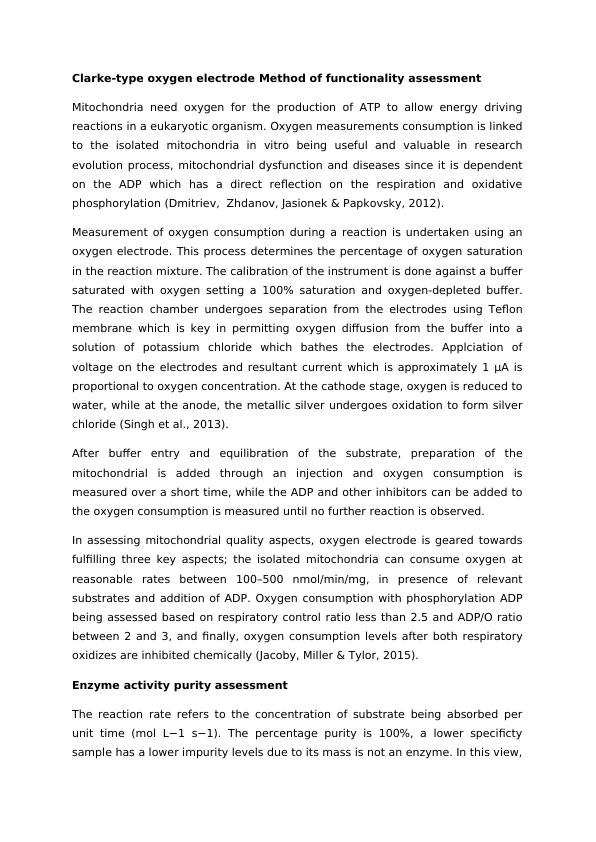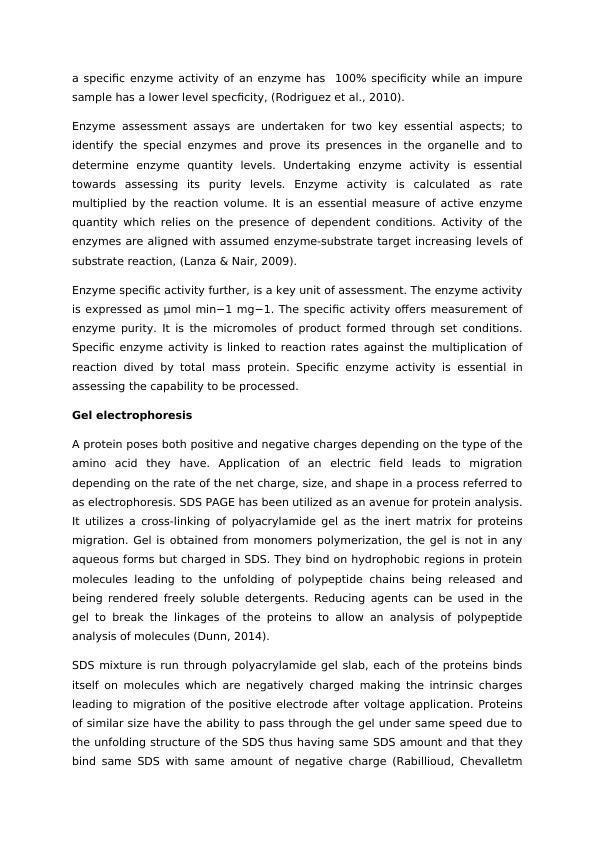Assessment on Cellular Organelle Isolation
Added on 2022-10-07
10 Pages3188 Words89 Views
Assessment on Cellular Organelle Isolation
UNIVERSITY
NAME
STUDENT ID:
COURSE CODE
Tutor
Purity and functionality of Golgi apparatus
UNIVERSITY
NAME
STUDENT ID:
COURSE CODE
Tutor
Purity and functionality of Golgi apparatus

Clarke-type oxygen electrode Method of functionality assessment
Mitochondria need oxygen for the production of ATP to allow energy driving
reactions in a eukaryotic organism. Oxygen measurements consumption is linked
to the isolated mitochondria in vitro being useful and valuable in research
evolution process, mitochondrial dysfunction and diseases since it is dependent
on the ADP which has a direct reflection on the respiration and oxidative
phosphorylation (Dmitriev, Zhdanov, Jasionek & Papkovsky, 2012).
Measurement of oxygen consumption during a reaction is undertaken using an
oxygen electrode. This process determines the percentage of oxygen saturation
in the reaction mixture. The calibration of the instrument is done against a buffer
saturated with oxygen setting a 100% saturation and oxygen-depleted buffer.
The reaction chamber undergoes separation from the electrodes using Teflon
membrane which is key in permitting oxygen diffusion from the buffer into a
solution of potassium chloride which bathes the electrodes. Applciation of
voltage on the electrodes and resultant current which is approximately 1 μA is
proportional to oxygen concentration. At the cathode stage, oxygen is reduced to
water, while at the anode, the metallic silver undergoes oxidation to form silver
chloride (Singh et al., 2013).
After buffer entry and equilibration of the substrate, preparation of the
mitochondrial is added through an injection and oxygen consumption is
measured over a short time, while the ADP and other inhibitors can be added to
the oxygen consumption is measured until no further reaction is observed.
In assessing mitochondrial quality aspects, oxygen electrode is geared towards
fulfilling three key aspects; the isolated mitochondria can consume oxygen at
reasonable rates between 100–500 nmol/min/mg, in presence of relevant
substrates and addition of ADP. Oxygen consumption with phosphorylation ADP
being assessed based on respiratory control ratio less than 2.5 and ADP/O ratio
between 2 and 3, and finally, oxygen consumption levels after both respiratory
oxidizes are inhibited chemically (Jacoby, Miller & Tylor, 2015).
Enzyme activity purity assessment
The reaction rate refers to the concentration of substrate being absorbed per
unit time (mol L−1 s−1). The percentage purity is 100%, a lower specificty
sample has a lower impurity levels due to its mass is not an enzyme. In this view,
Mitochondria need oxygen for the production of ATP to allow energy driving
reactions in a eukaryotic organism. Oxygen measurements consumption is linked
to the isolated mitochondria in vitro being useful and valuable in research
evolution process, mitochondrial dysfunction and diseases since it is dependent
on the ADP which has a direct reflection on the respiration and oxidative
phosphorylation (Dmitriev, Zhdanov, Jasionek & Papkovsky, 2012).
Measurement of oxygen consumption during a reaction is undertaken using an
oxygen electrode. This process determines the percentage of oxygen saturation
in the reaction mixture. The calibration of the instrument is done against a buffer
saturated with oxygen setting a 100% saturation and oxygen-depleted buffer.
The reaction chamber undergoes separation from the electrodes using Teflon
membrane which is key in permitting oxygen diffusion from the buffer into a
solution of potassium chloride which bathes the electrodes. Applciation of
voltage on the electrodes and resultant current which is approximately 1 μA is
proportional to oxygen concentration. At the cathode stage, oxygen is reduced to
water, while at the anode, the metallic silver undergoes oxidation to form silver
chloride (Singh et al., 2013).
After buffer entry and equilibration of the substrate, preparation of the
mitochondrial is added through an injection and oxygen consumption is
measured over a short time, while the ADP and other inhibitors can be added to
the oxygen consumption is measured until no further reaction is observed.
In assessing mitochondrial quality aspects, oxygen electrode is geared towards
fulfilling three key aspects; the isolated mitochondria can consume oxygen at
reasonable rates between 100–500 nmol/min/mg, in presence of relevant
substrates and addition of ADP. Oxygen consumption with phosphorylation ADP
being assessed based on respiratory control ratio less than 2.5 and ADP/O ratio
between 2 and 3, and finally, oxygen consumption levels after both respiratory
oxidizes are inhibited chemically (Jacoby, Miller & Tylor, 2015).
Enzyme activity purity assessment
The reaction rate refers to the concentration of substrate being absorbed per
unit time (mol L−1 s−1). The percentage purity is 100%, a lower specificty
sample has a lower impurity levels due to its mass is not an enzyme. In this view,

a specific enzyme activity of an enzyme has 100% specificity while an impure
sample has a lower level specficity, (Rodriguez et al., 2010).
Enzyme assessment assays are undertaken for two key essential aspects; to
identify the special enzymes and prove its presences in the organelle and to
determine enzyme quantity levels. Undertaking enzyme activity is essential
towards assessing its purity levels. Enzyme activity is calculated as rate
multiplied by the reaction volume. It is an essential measure of active enzyme
quantity which relies on the presence of dependent conditions. Activity of the
enzymes are aligned with assumed enzyme-substrate target increasing levels of
substrate reaction, (Lanza & Nair, 2009).
Enzyme specific activity further, is a key unit of assessment. The enzyme activity
is expressed as μmol min−1 mg−1. The specific activity offers measurement of
enzyme purity. It is the micromoles of product formed through set conditions.
Specific enzyme activity is linked to reaction rates against the multiplication of
reaction dived by total mass protein. Specific enzyme activity is essential in
assessing the capability to be processed.
Gel electrophoresis
A protein poses both positive and negative charges depending on the type of the
amino acid they have. Application of an electric field leads to migration
depending on the rate of the net charge, size, and shape in a process referred to
as electrophoresis. SDS PAGE has been utilized as an avenue for protein analysis.
It utilizes a cross-linking of polyacrylamide gel as the inert matrix for proteins
migration. Gel is obtained from monomers polymerization, the gel is not in any
aqueous forms but charged in SDS. They bind on hydrophobic regions in protein
molecules leading to the unfolding of polypeptide chains being released and
being rendered freely soluble detergents. Reducing agents can be used in the
gel to break the linkages of the proteins to allow an analysis of polypeptide
analysis of molecules (Dunn, 2014).
SDS mixture is run through polyacrylamide gel slab, each of the proteins binds
itself on molecules which are negatively charged making the intrinsic charges
leading to migration of the positive electrode after voltage application. Proteins
of similar size have the ability to pass through the gel under same speed due to
the unfolding structure of the SDS thus having same SDS amount and that they
bind same SDS with same amount of negative charge (Rabillioud, Chevalletm
sample has a lower level specficity, (Rodriguez et al., 2010).
Enzyme assessment assays are undertaken for two key essential aspects; to
identify the special enzymes and prove its presences in the organelle and to
determine enzyme quantity levels. Undertaking enzyme activity is essential
towards assessing its purity levels. Enzyme activity is calculated as rate
multiplied by the reaction volume. It is an essential measure of active enzyme
quantity which relies on the presence of dependent conditions. Activity of the
enzymes are aligned with assumed enzyme-substrate target increasing levels of
substrate reaction, (Lanza & Nair, 2009).
Enzyme specific activity further, is a key unit of assessment. The enzyme activity
is expressed as μmol min−1 mg−1. The specific activity offers measurement of
enzyme purity. It is the micromoles of product formed through set conditions.
Specific enzyme activity is linked to reaction rates against the multiplication of
reaction dived by total mass protein. Specific enzyme activity is essential in
assessing the capability to be processed.
Gel electrophoresis
A protein poses both positive and negative charges depending on the type of the
amino acid they have. Application of an electric field leads to migration
depending on the rate of the net charge, size, and shape in a process referred to
as electrophoresis. SDS PAGE has been utilized as an avenue for protein analysis.
It utilizes a cross-linking of polyacrylamide gel as the inert matrix for proteins
migration. Gel is obtained from monomers polymerization, the gel is not in any
aqueous forms but charged in SDS. They bind on hydrophobic regions in protein
molecules leading to the unfolding of polypeptide chains being released and
being rendered freely soluble detergents. Reducing agents can be used in the
gel to break the linkages of the proteins to allow an analysis of polypeptide
analysis of molecules (Dunn, 2014).
SDS mixture is run through polyacrylamide gel slab, each of the proteins binds
itself on molecules which are negatively charged making the intrinsic charges
leading to migration of the positive electrode after voltage application. Proteins
of similar size have the ability to pass through the gel under same speed due to
the unfolding structure of the SDS thus having same SDS amount and that they
bind same SDS with same amount of negative charge (Rabillioud, Chevalletm

End of preview
Want to access all the pages? Upload your documents or become a member.
Related Documents
Assessing Effects of Substrates, ADP and Inhibitors on Mitochondrial Respirationlg...
|13
|3448
|93
Biology Practical Questionslg...
|7
|1601
|268